Orbea recently launched an all-new version of their racing bike platform, the Orca. The new Orbea Orca OMX takes inspiration from both the Orca Aero and Orca OMR, marrying aero elements from the former with the lightweight, functional performance credentials of the latter to create a machine that aims to add up to something more. Aero features, dropped seat stays and huge tire clearances. Is this the people’s road bike?
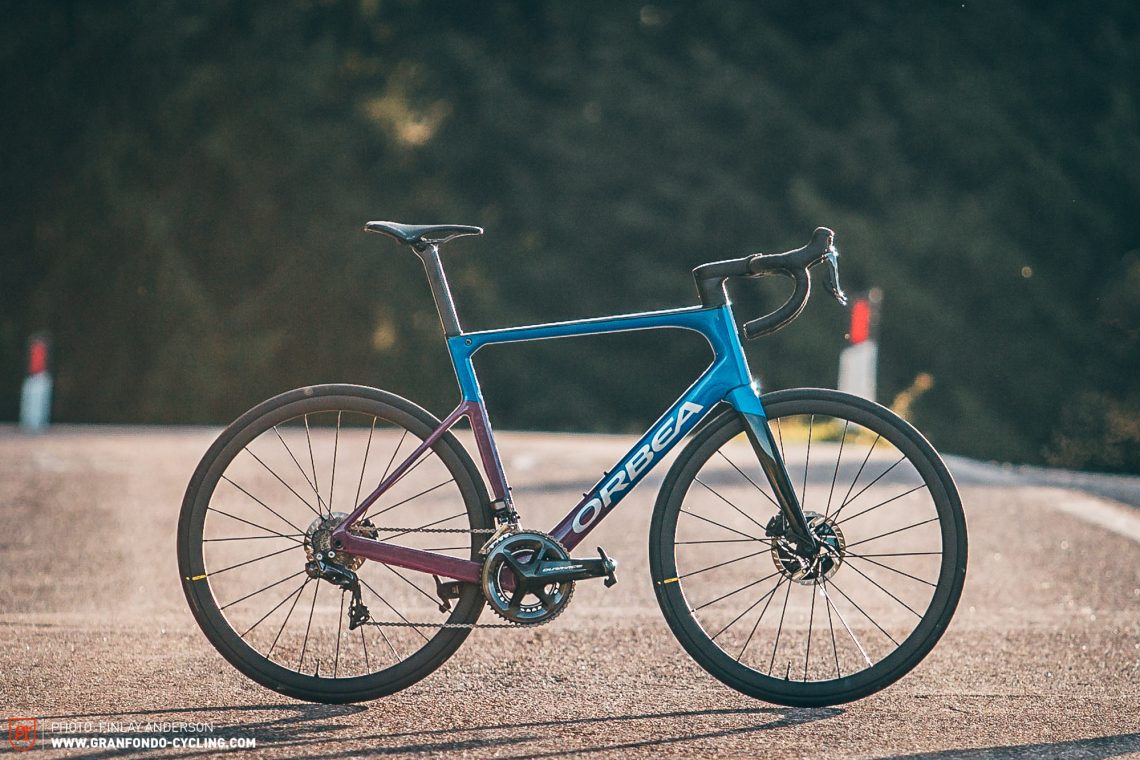
The Orca OMX is complete redesign of the platform and adds what we can only describe as an endurance-, aero-, performance- crossover road bike to Orbea’s lineup. So far, Orbea’s two race offerings have been aero-focussed Orca Aero and the lightweight Orca OMR. While these remain part of Orbea’s range, the new bike takes elements from both to create what is, while still for all intents and purposes a road racer, also something that offers that little bit more. It’s particularly interesting that Orbea have been clear that this is a bike designed around the changing needs of the modern rider. Yes, it might have a claimed 15% increase in stiffness and 10% reduction in drag over the Orca OMR, but it’s also not as all-out race bike as you might expect. It’s a step towards a bike that is very capable as more than just a single-minded road bike.
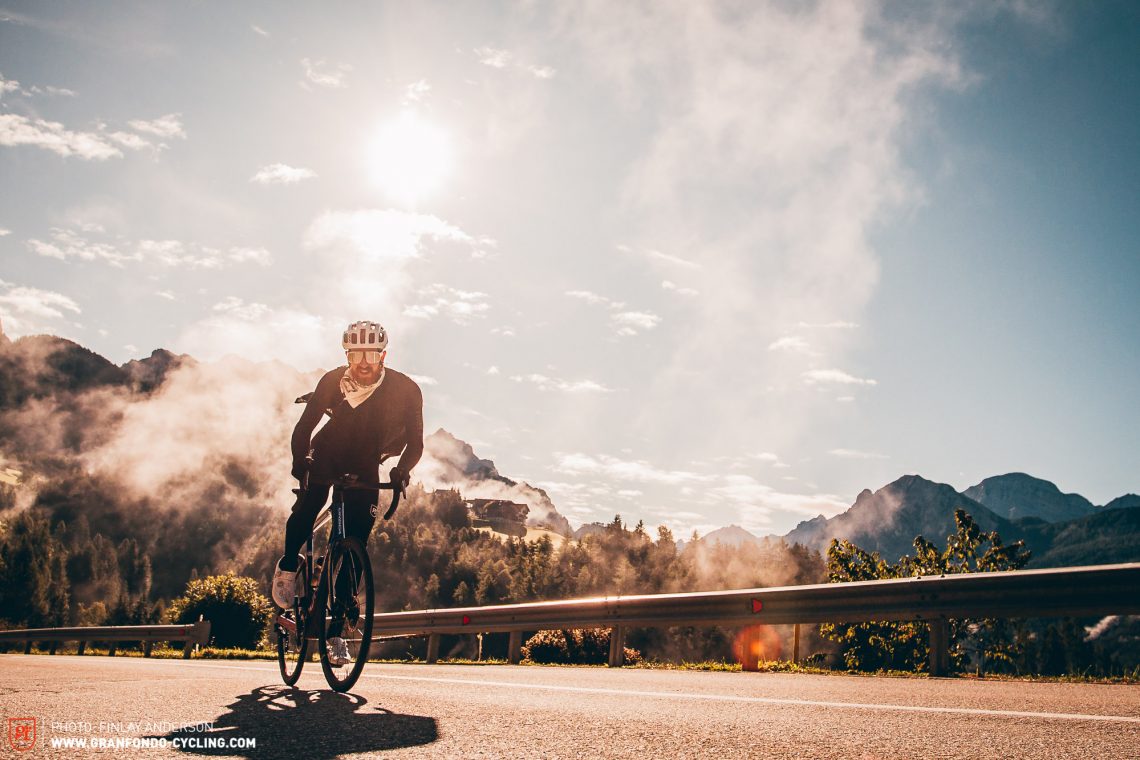
The Orbea Orca OMX in detail
You could be forgiven for thinking that the new Orbea OMX looks an awful lot like many other recent road bikes. Gone are the traditional twin triangle frame design and rim brakes of the Orca OMR and in come dropped seat stays, aero features and a disc brake only frame. The new frame has a claimed weight of 833 g (size 53), with the fork weighing 370 g. Given the increasing optimisation of road bikes, it’s not all that surprising that road bikes are looking ever more similar, but the Orca OMX has a few tricks up its sleeve.
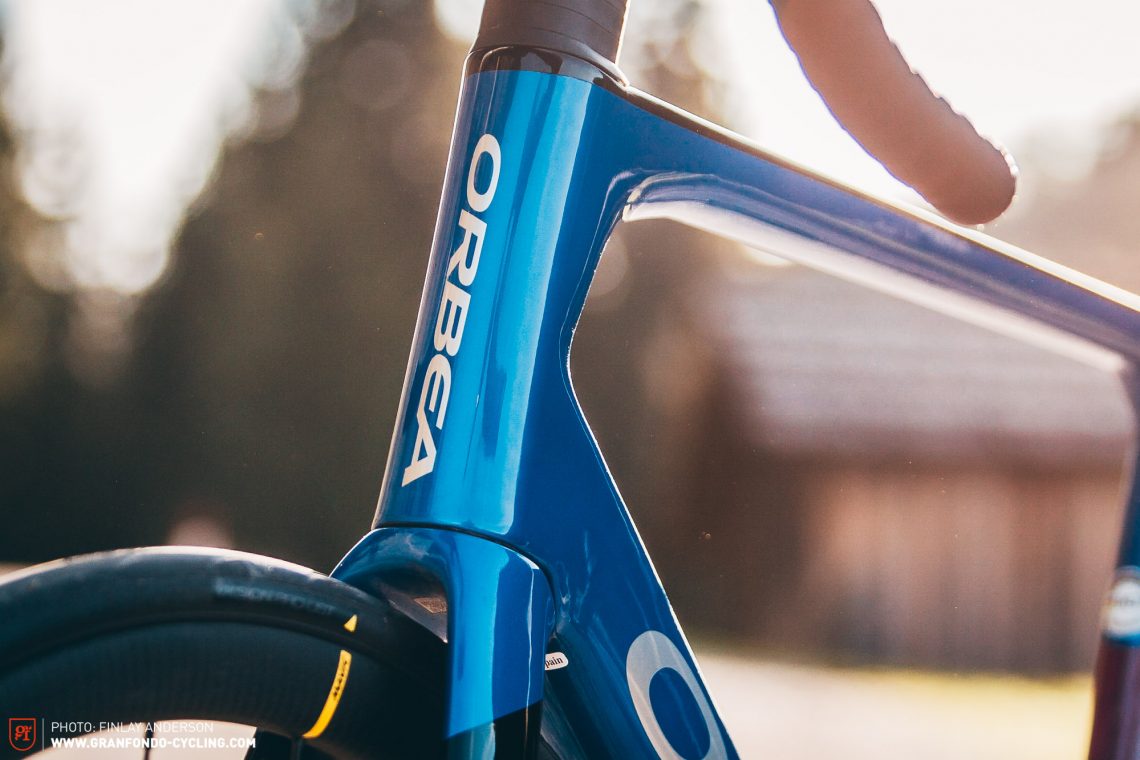
With its undeniably racy geometry, the Orca OMX might belie its versatility. While the build that we have is fitted with 25 mm tires, it has clearances for up to 32 mm tires, placing this bike firmly in the realm of all-road bikes. That may not quite as much as found on the Trek Domane, but it nonetheless indicates the trend for road bikes to be more consumer oriented. Indeed, while the Orca OMX has all the features and updates you would expect of a modern high-end road bike, Orbea have given a definite nod to the fact that customers nowadays want more from their bike. Those large tire clearances stand somewhat in contrast to what you might expect from its racy geometry.
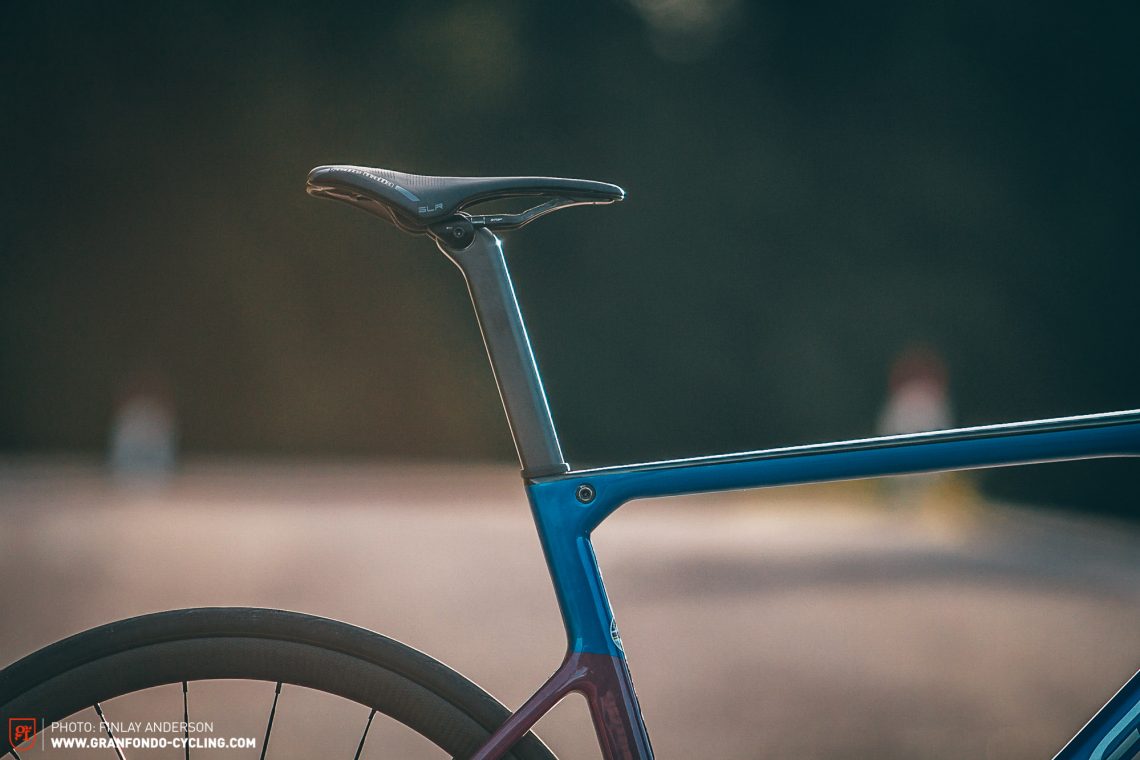
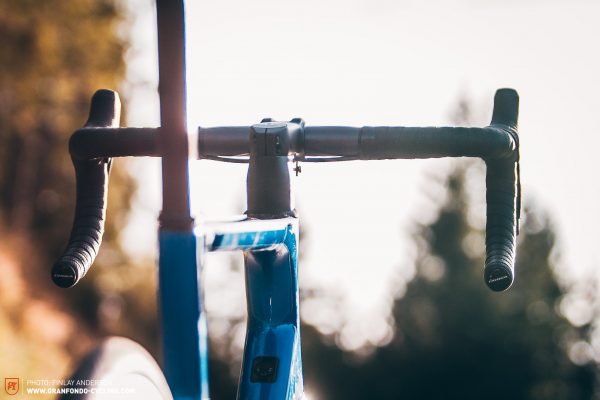

That means a bike that isn’t optimised to within an inch of its life but also one that stays practical in a range of different applications. While the Orca OMX isn’t going to be as all-out aero as the Orca Aero, it still features aero tube shapes with Kamm tail tube shaped, a proprietary D-shaped seatpost, dropped seat stays both to improve aerodynamics and comfort as well as increased integration throughout the build. It also adopts the distinctive bow-legged “Free Flow” fork of the Orca Aero, the wide stance of which is designed to clear the turbulent airflow around the wheel. That results in a claimed saving of 27 seconds over 50 km, though you’ll have to be riding at a speedy 50 km/h!
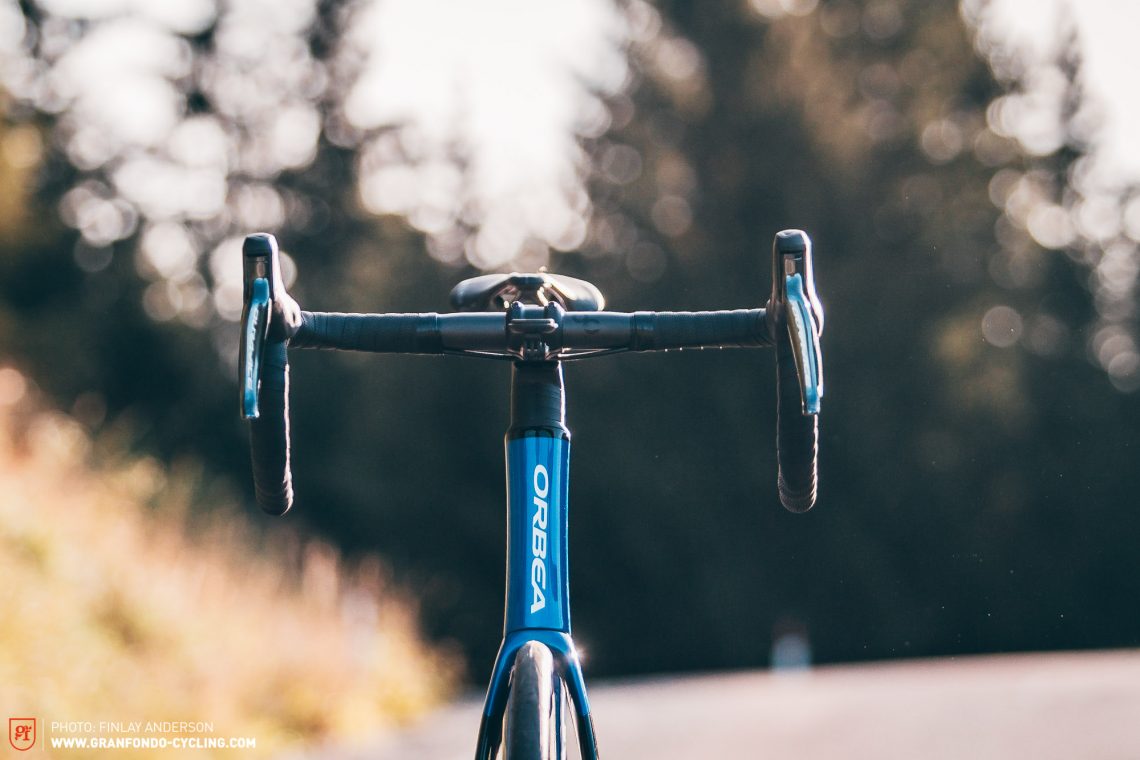
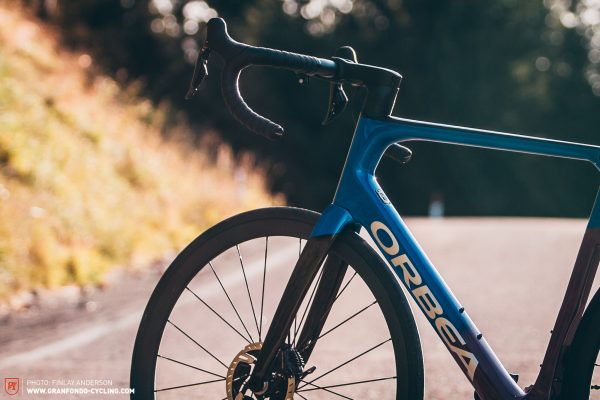

But the Orca isn’t aero at the expense of all else. While the Orca OMX marks the first time that Orbea offers a fully integrated bike, it is achieved with a two-piece bar stem combo that allows the user to mix and match (standard) bars as required. Overall, while the complete integration may not be the most refined solution that we have seen, it is at the same time one of the most user-friendly out there, allowing changes to be made easily. The cables route on the underside of the proprietary ICR stem under a plastic cover through split steerer spacers, making changes to position easy. Admittedly that might not be a huge advantage once you’re set up but is a nice nod to user-friendliness and it’s nice that the routing is happy with both electronic and mechanical shifting.
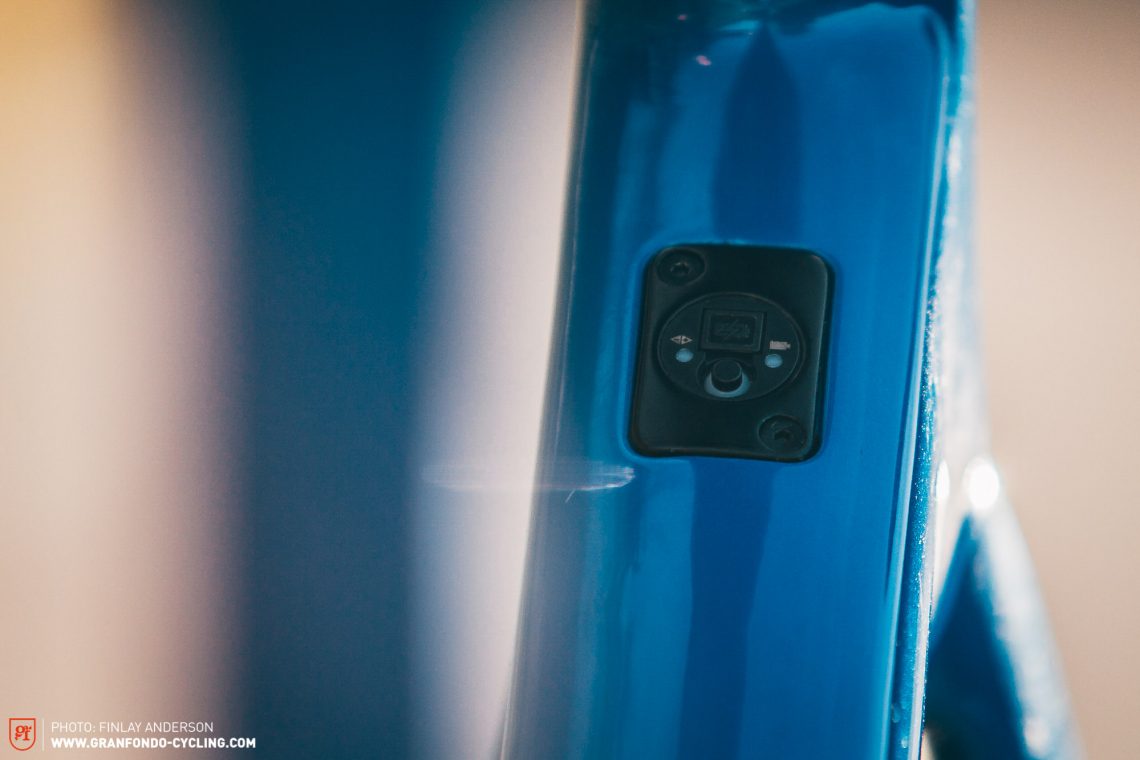
Integration continues with the option to integrate a Di2 junction box in the down tube and a Di2 battery in the base of the proprietary D-shaped seatpost. Likewise, a neatly integrated seatpost clamp is easily accessible with the bolt on the side of the top tube, rather than hidden away in a hard to reach place as some other manufacturers are wont to do. The one-bolt seatpost can be run with either 25 or 0 mm offset, simply by flipping the clamps.
Given the increasing similarities between bike designs manufacturers need to set themselves apart somehow. Arguably, Orbea’s MyO customisation programme is one of its most defining features, allowing you to create your own custom finish from a plethora of options at no extra cost and in turn, a design unique just to you. The Orca we had delivered came in a rather fetching black-purple-blue colour scheme. The configurator also allows (limited) customisation of components such as wheels, as well as changing cassette, stem length and bar width.
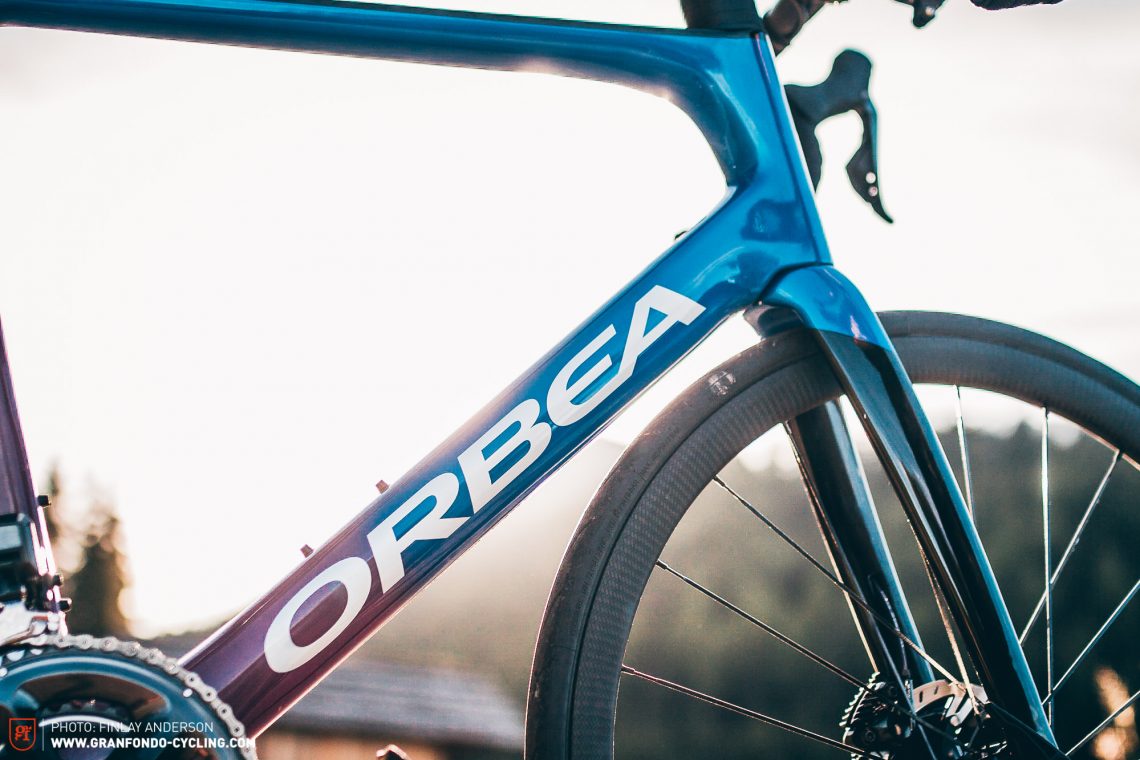
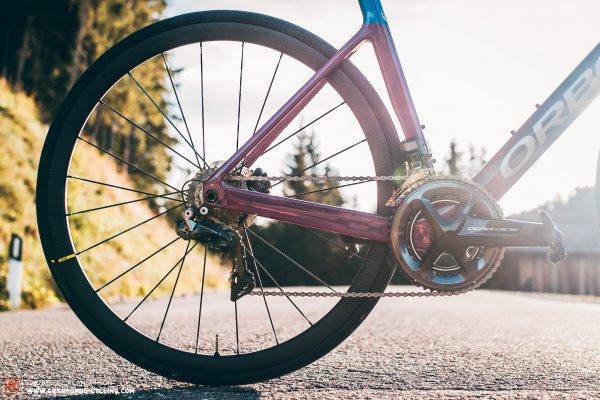
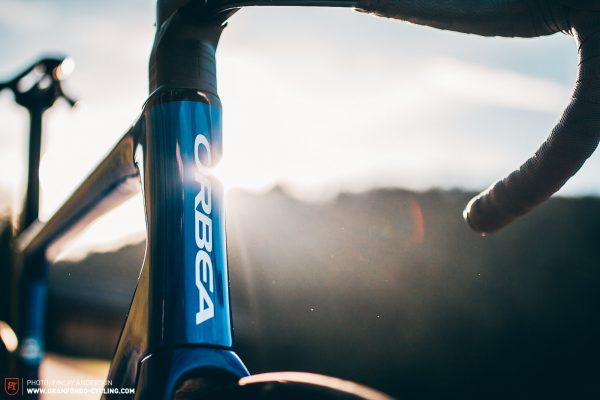
Overall, where the Orbea really shines is in its aspiration to be a versatile bike suitable for consumers and not just pro-level racers. In our view, this bike indicates ever more clearly the changing trend in the industry to produce bikes that can be ridden and not just raced. Yes, it might have a racing heritage but racing isn’t at the forefront of the design brief here. Instead, the bike has been designed with the consumer in mind.
Orbea Orca M10iLTD-D – our test bike
We were riding the second most expensive model in the range, fitted with a Shimano DURA-ACE Di2 drivetrain instead of the new 12-speed SRAM AXS on the top-end model.
Drivetrain Shimano DURA-ACE 9170 Di2
Cassette Shimano DURA-ACE 9100 11-28 t
Brakes Shimano R9170 Hydraulic Disc
Wheelset Mavic Ksyrium Pro Carbon Disc UST CL
Tires Mavic Yksion Pro 700×25
Seatpost Orbea Orca OMX SB0
Handlebar Orbea OC2 Road Carbon
Stem Orbea ICR
Weight 7.43 kg in size 57
Price € 8,999
Sizes 47, 49, 51, 53, 55, 57, 60
Colour Custom colours through MyO programme
Availability available to order now
The other models in the range
M11eLTD-D
Drivetrain SRAM Red eTap AXS
Cassette SRAM XG-1290 10-28t 12-speed
Brakes SRAM Red eTap AXS
Wheelset Mavic Ksyrium Pro Carbon Disc UST CL
Tires Mavic Yksion Pro 700×25
Seatpost Orbea Orca OMX SB0
Handlebar Orbea OC2 Road Carbon
Stem Orbea ICR
Price € 9,499
Sizes 47, 49, 51, 53, 55, 57, 60
Colour Custom colours through MyO programme
Availability available to order now
M21eLTD-D
Drivetrain SRAM Force eTap AXS
Cassette SRAM XG-1270 10-28t 12-speed
Brakes SRAM Force eTap AXS
Wheelset Vision 40 SC Disc Carbon TLR CL
Tires Hutchinson Fusion 5 All Season TLR 700×25
Seatpost Orbea Orca OMX SB0
Handlebar Orbea OC2 Road Carbon
Stem Orbea ICR
Price € 5,999
Sizes 47, 49, 51, 53, 55, 57, 60
Colour Custom colours through MyO programme
Availability available to order now
M20iLTD-D
Drivetrain Shimano ULTEGRA R8000 Di2
Cassette Shimano ULTEGRA R8000 11-28t
Brakes Shimano ULTEGRA R8070 Hydraulic Disc
Wheelset Vision 40 SC Disc Carbon TLR CL
Tires Hutchinson Fusion 5 All Season TLR 700×25
Seatpost Orbea Orca OMX SB0
Handlebar Orbea OC2 Road Carbon
Stem Orbea ICR
Price € 5,699
Sizes 47, 49, 51, 53, 55, 57, 60
Colour Custom colours through MyO programme
Availability available to order now
M20LTD-D
Drivetrain Shimano ULTEGRA R8000
Cassette Shimano ULTEGRA R8000 11-28t
Brakes Shimano ULTEGRA R8070 Hydraulic Disc
Wheelset Vision 40 SC Disc Carbon TLR CL
Tires Hutchinson Fusion 5 All Season TLR 700×25
Seatpost Orbea Orca OMX SB0
Handlebar Orbea OC2 Road Carbon
Stem Orbea ICR
Price € 4,699
Sizes 47, 49, 51, 53, 55, 57, 60
Colour Custom colours through MyO programme
Availability available to order now
The geometry of the Orbea Orca OMX
| Size | 47 | 49 | 51 | 53 | 55 | 57 | 60 |
|---|---|---|---|---|---|---|---|
| Seat tube | 440 mm | 460 mm | 480 mm | 500 mm | 520 mm | 540 mm | 570 mm |
| Top tube | 510 mm | 523 mm | 536 mm | 549 mm | 560 mm | 576 mm | 590 mm |
| Head tube | 106 mm | 113 mm | 130 mm | 148 mm | 168 mm | 186 mm | 213 mm |
| Head angle | 71.0° | 71.5° | 72.2° | 72.8° | 73.0° | 73.2° | 73.2° |
| Seat angle | 74.5° | 74.0° | 73.7° | 73.5° | 73.5° | 73.2° | 73.2° |
| Chainstay | 408 mm | 408 mm | 408 mm | 408 mm | 408 mm | 408 mm | 408 mm |
| BB Drop | 72 mm | 72 mm | 72 mm | 70 mm | 70 mm | 70 mm | 70 mm |
| Wheelbase | 972 mm | 976 mm | 980 mm | 981 mm | 991 mm | 1,002 mm | 1,016 mm |
| Reach | 370 mm | 376 mm | 380 mm | 385 mm | 391 mm | 398 mm | 404 mm |
| Stack | 506 mm | 515 mm | 533 mm | 552 mm | 572 mm | 590 mm | 616 mm |
The Orbea Orca OMX M10iLTD-D on test
The Orbea Orca OMX that we have in for testing makes a strong first impression. The dropped seat stays make for a purposeful looking bike while the custom MyO blue-purple-black finish is beautifully executed, with a particular highlight the fade between colours on the down tube. Likewise, the Shimano DURA-ACE Di2 build is impeccably put together and not going to be a cause for any complaints. Additionally, sensible component choices like the 160 mm disc rotor up front are a welcome nod to practical everyday use. Of course, Orbea also permit a degree of customisation here should you want different components. In this overall very tidy picture, the only visual blemish is the tiny section of cabling exposed in the transition from bar to stem, though as mentioned, this simultaneously offers additional flexibility regarding bar choice and fit.
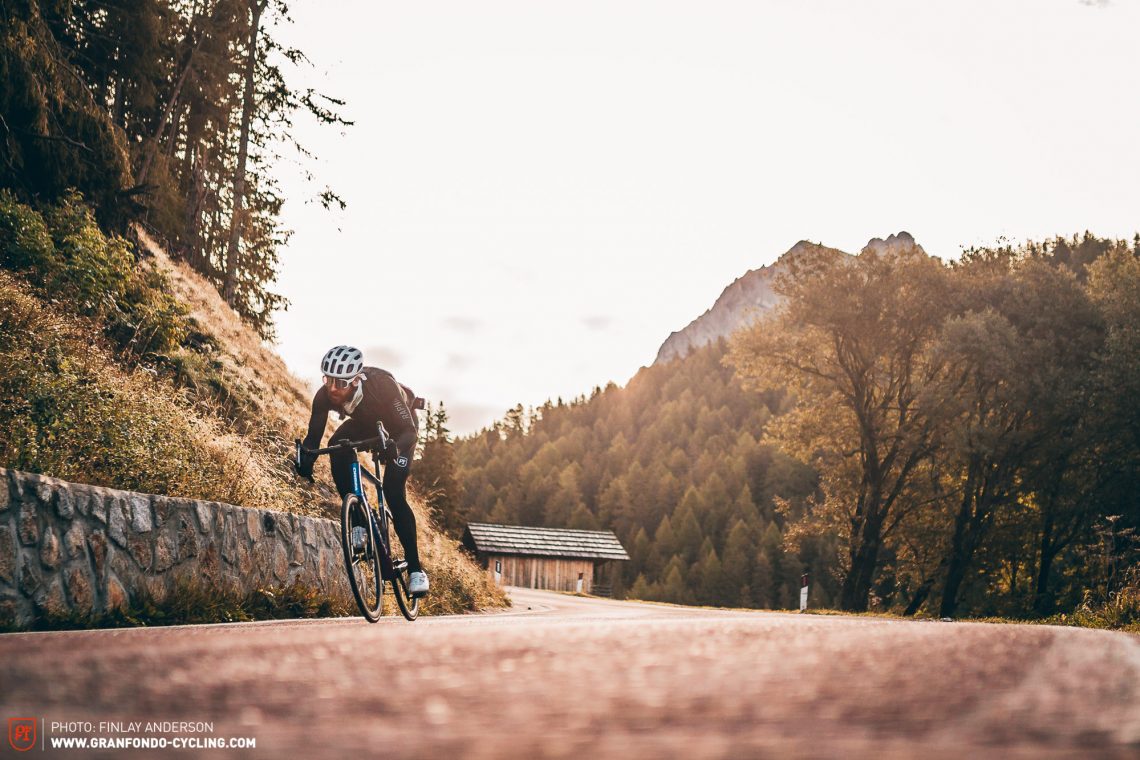
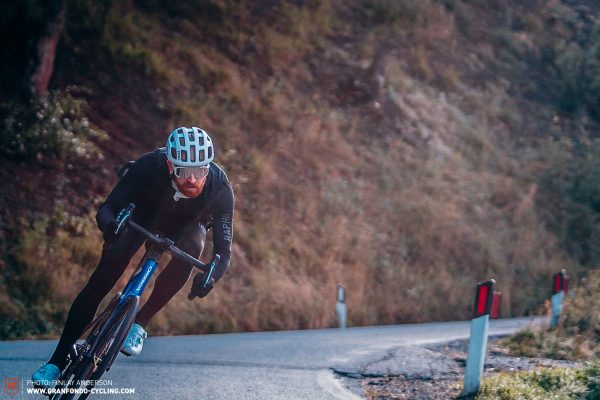

Some may decry the generous clearances around the 25 mm tires fitted as ungainly, but we feel that the overall proportions of the Orca harmonise well. In its traditional, skinny-tired configuration, the Orca offers a sporty and thoroughbred racing ride. However, we’d appreciate both wider wheels and tires for increased comfort and all-road capabilities. It feels just like a race bike should, with agile but well-balanced handling. The short 408 mm chainstays and relatively steep head angle result in a quick turning bike, while the grippy, tubeless Mavic Yksion tires (which use Hutchinson’s 11Storm rubber compound) provide a surefooted stance in dry conditions. The Orca also remains pleasantly stable at high speeds, likely thanks to the slightly lower 72mm bottom bracket. The only caveat here is that some riders may have issues with toe overlap due to the short front centre. That’s likely not an issue in most riding scenarios aside from slow speed cornering or a casual track stand at the traffic lights, but it’s nonetheless worth mentioning. That quirk aside, the riding position is nicely centred without putting you in an excessively aggressive position. Compared to some more dedicated racing bikes, the stack is slightly higher resulting in a slightly more relaxed ride.
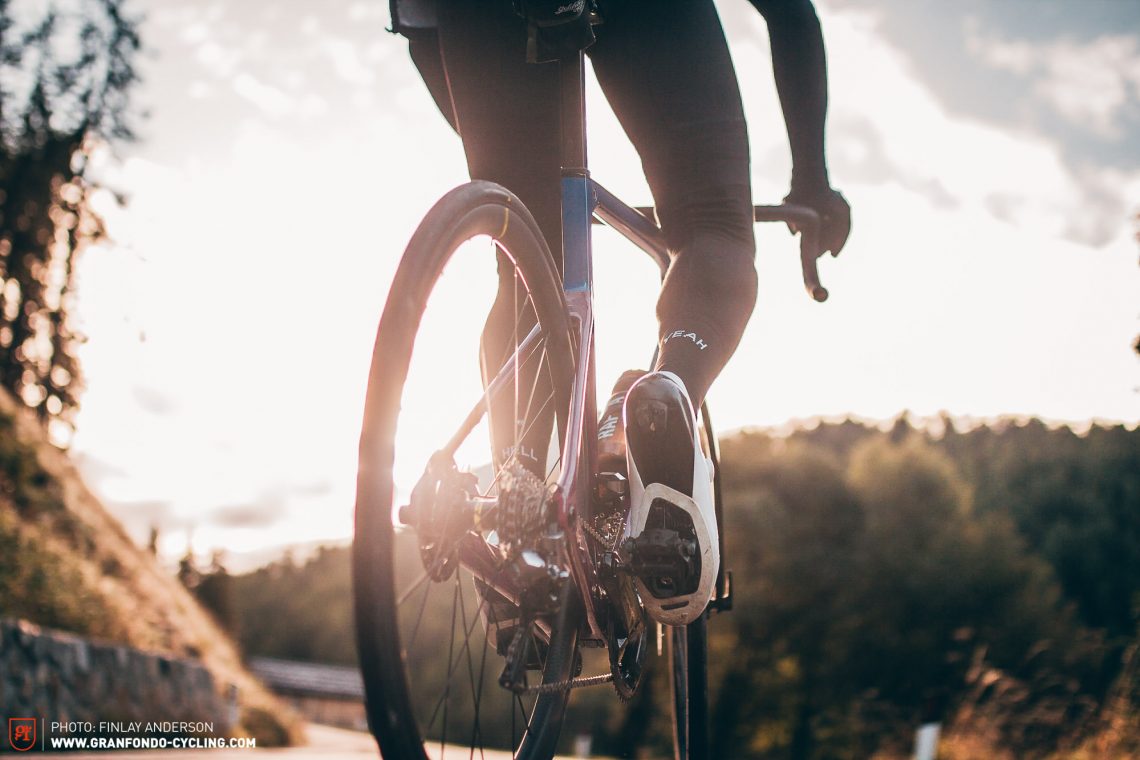

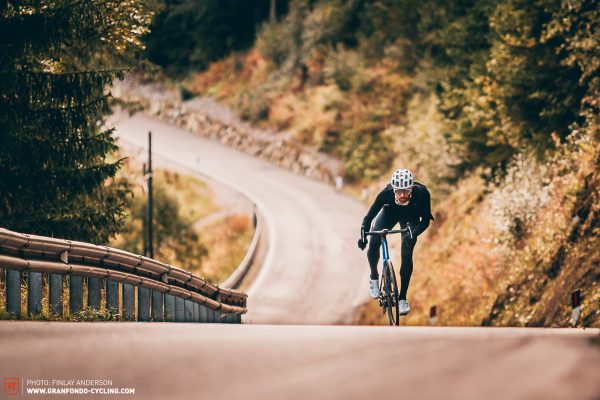
Unfortunately, we haven’t yet been able to ride the Orca with 32mm tires, but are excited to see to what extent these will expand its capabilities. The bike’s overall comfort is acceptable with the 25 mm tires, but we expect a much more cushioned ride with higher volume rubber. However, at this point, it’s important to note that while the new Orca has traditional geometry, it’s clear that it has not been tuned to within an inch of its life in search of the ultimate performance. Its race bike handling belies the fact that it is actually a very versatile bike. It combines a smattering of aero features and increased stiffness over the Orca OMR, but is also decidedly practical with the ability to use a standard bar and fit, for the road bike world, huge tires.
That could easily leave the Orca in a no man’s land of features that don’t harmonise into a coherent concept. However, in this case, they come together into a truly versatile bike that can be a dab hand at anything you want. It may not be the ultimate performer in any one discipline, but as one bike to do it all, it could be just the one you need.
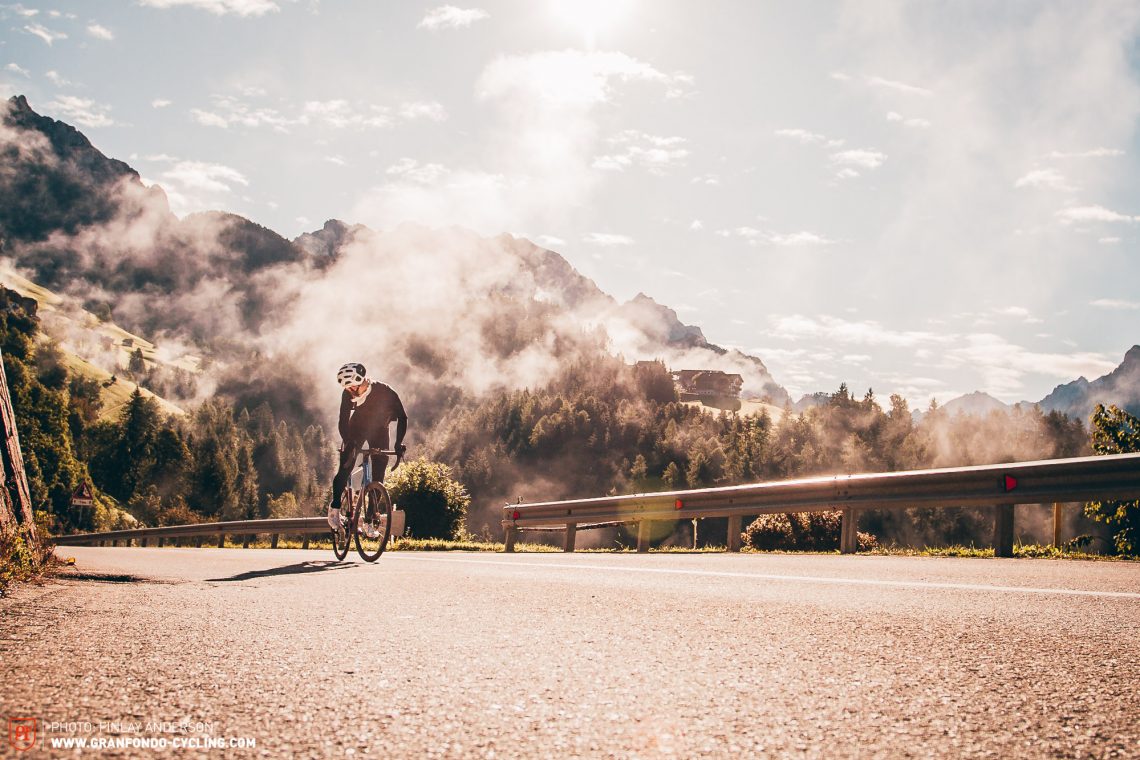
Conclusion
The Orbea Orca OMX currently sits in a relatively unique place on the market with a combination of performance geometry and all-road tire clearances. However, it is also surely a sign of things to come. Bikes such as the new Trek Domane may offer even bigger clearances, but with much more relaxed geometry, while options such as the Specialized Tarmac, with its racier geometry, are still limited to 30 mm tires. The Orca OMX is a compelling proposition for those who are looking for just one road bike, ranging from performance to endurance, that can offer something more…
For more information head to orbea.com

Did you enjoy this article? If so, we would be stoked if you decide to support us with a monthly contribution. By becoming a supporter of GRAN FONDO, you will help secure a sustainable future for high-quality cycling journalism. Click here to learn more.
Words: Benedict Pfender Photos: Finlay Anderson







